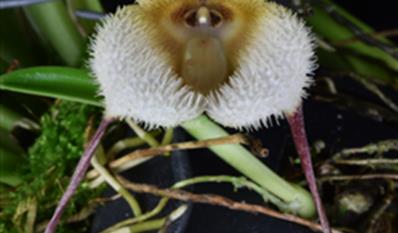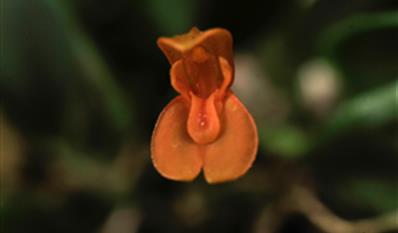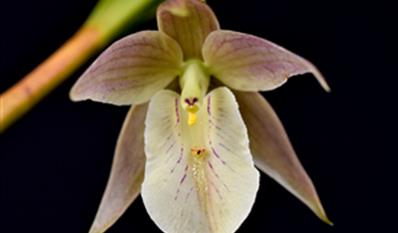
Paphiopedilum-myanmaricum-2023-09-17 *SITF confirms that this plant is Paphiopedilum myanmaricum (Feb 2024).
This plant has been identified by Harold Koopowitz, who was the taxonomist of record for this species; He stated it was Paphiopedilum myanmaricum without a doubt. There are 20 supporting photos of P. myanmaricum in the orchidroots.com which closely match this plant, including distinctive spotted round to oval staminodes with a yellow spot in the center. There is also a very good photo in the IOSPE which matches this plant.
Posted on Sep 17, 2023
vendor : Tropical Exotique

Habenaria-macroceratitis-2023-09-05 *SITF confirms this plant is Habenaria macroceratitis (Sep 2023).
Confirmation is based on the description in McVaugh's 1985 "Flora Novo-Galiciana" (Vol. 160) which delineates the difference between this species and H. quinqueseta. The key characteristic is the difference between the upper and lower lobes of the petals with H. macroceratitis being greater than H. quinqueseta in the lower lobe, as seen in this plant. Also, this plant matches the description and key in Brown's 2002 "Wild Orchids of Florida". It is close match to Subrahmanyam's photo in the IOSPE and photos in the orchidroots.com.
Posted on Sep 5, 2023
Ten flowers and four buds spirally arranged on a 69.2 cm staked racemose inflorescence; 22 cm diameter plant grown in a 12 cm diameter pot in terrestrial mix; leaves lanceolate to 14 cm long by 4 cm w...

Prosthechea-joaquingarciana-Rita-Emilia-CBR/AOS-2023-08-25 *SITF confirms this plant is Prosthechea joaquingarciana (Oct 2023).
This plant matches the description and photo of P. joaquingarciana in the IOSPE (as the synonym Anacheilum joaquingarcianum) and Pupulin's original description in Selbyana 22(1):19. 2001; a photo and drawing can be found in https://epidendra.com/. It is similar to P. radiata, but P. joaquingarciana has linear, subterete, sulcate pseudobulbs and spots on the segments with a widely ovate lip as does this plant. The pseudobulbs of this plant measure 25 cm, which is in range and the flower size also meets the description. This plant had many blooms on a two-leafed pseudobulb, which eliminates the 2-flowered P. baculus and P. baculibulbum, which has 3-leaves.
Posted on Aug 25, 2023
Plant native to Costa Rica. It was identified by Franco Pupulin who was on site and also the author of this species description (Prosthechea joaquingarciana Pupulin, Selbyana 22(1):19. 2001).

Dracula-saulii-2023-08-24 *SITF confirms that this plant is Dracula saulii (Aug 2023).
This plant exactly matches the description and findings of Dracula saulii 02-14-2023, award number 20234261. The key characteristic of D. saulii, besides the velutinous hairs covering the flower, is the unusual length of the dorsal cauda compared to the lateral caudae; in D. saulii, the dorsal tail is two to three times shorter than the length of the lateral tails. In this flower the dorsal sepal cauda is 4.2 cm and the lateral sepal caudae is 11.5 cm. D. saulii is also distinguished by its small size and narrowly linear, obtuse leaves. The only other species that appears close is D. adrianae, but all the caudae on D. adrianae are about the same length and it differs in its plant characteristics. This plant displays distinctive, reflexed segments and dense spicules on the surfaces of the segments as does D. saulii.
Posted on Aug 24, 2023
Description is as follows:
"Nine flowers on nine up to 8.5-cm inflorescences with numerous emerging inflorescences; sepals broadly mucronate, dorsal fully recurved, synsepals recurved, sepals and cau...

Specklinia-gersonii-2023-08-24 *SITF confirms that this plant is Specklinia gersonii (Aug 2023).
Identification was confirmed on-site by Dr. Franco Pupulin and Dr. Adam Karremans (one of the authors who published the taxonomic description). S. gersonii has obovate leaves and its related species are more linear. The color matches and the leaf shape agrees with the description; two photos of S. gersonii in the IOSPE also match this plant. Photos of the plant and flower in the OW are perfect matches, as well. Flower size seems slightly large.
Posted on Aug 24, 2023
This species is native to Costa Rica and the ID was confirmed by Franco Pupulin and Adam Karremans who were on site. Adam was one of the authors who published the description of Specklinia gersonii.&n...

Scaphyglottis-pulchella-2023-08-24 *SITF confirms this that this plant is Scaphyglottis pulchella (Aug 2023).
Scaphyglottis pulchella and S. clavata are very similar; however, Scaphyglottis pulchella plants are almost reedstemmed, whereas those of S. clavata have distinctly swollen upper sections (Club-Shaped) and much broader leaves. Also, S. pulchella has larger flowers with larger, fatter sepals and petals and a wider lip. Supporting images are found in the IOSPE, orchidroots.com and the OW. Identification was confirmed as well by Dr. Franco Pupulin.
Posted on Aug 24, 2023
The ID was confirmed by Franco Pupulin who was on site. Scaphyglottis pulchella 'Caleb Emiliano' CHM/84 20236216Nineteen pendent, nodding flowers and one bud on 17 fasciculate inflore...